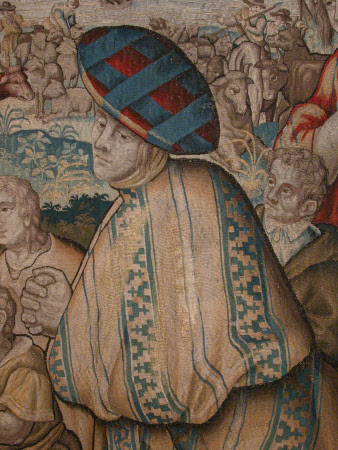The Reconciliation of Jacob and Esau (fragment)
Flemish
Category
Tapestries
Date
circa 1560 - circa 1580
Materials
Tapestry, wool and silk, 6-6½ warps per cm
Measurements
2450 x 1030 mm
Order this imageCollection
Packwood House, Warwickshire
NT 557885
Summary
Tapestry, wool and silk, 6-6½ warps per cm, The Reconciliation of Jacob and Esau (fragment), Flemish, c.1560-1580. A vertical strip of tapestry cut from a larger piece, showing a kneeling female figure wearing a golden cloak with broad blue stripes and a circular hat with red and blue bands, surrounded by a group of figures all kneeling and facing left. Beyond the woman on the left are a young man and a boy. To the right, cut in half by the edge of the tapestry, is a standing woman wearing a turban and gesturing to her chest. At the lower edge of the tapestry there are small stones, moss and ivy leaves on the ground, and to the left the foot of another kneeling figure is visible. In the background there is a landscape with cows and cowherds, and a band of sea beyond with an imaginary city on an island or promontory. Small birds fly about in the sky.
Full description
This fragment has been cut from a larger piece representing the Reconciliation of Jacob and Esau, of which a complete example is in the Museum of Applied Arts, Budapest (László and Kiadó 1981, cat. no. 9, pp. 46-47, 82 and pls. 35-37). The event depicted is the meeting of the estranged twin brothers Jacob and Esau, the sons of Isaac and Rebecca (Gen. 33). The military leader Esau came to meet his brother with 400 men, and Jacob came with his four wives Rachel and Leah, the daughters of Laban, Bilhah and Zilpah, their two ‘handmaidens’, and their eleven sons. Jacob was afraid that his brother might harm his wives and children, so he placed the handmaidens and their sons at the head of the procession, and Rachel, his favourite, and her son Joseph, at the back. But when they met the brothers were instantly reconciled: “and Esau ran to meet him, and embraced him, and fell on his neck, and kissed him: and they wept” (Gen.33.4). Unfortunately we cannot see this event in the fragment at Packwood, as it takes place in the section that has been removed on the left. The foot at the lower left corner is Jacob’s, and the kneeling woman is one of his wives, presumably either Bilhah or Zilpah. The two young men are her sons. The cows in the background probably allude to the flocks which Jacob took with him when he left Laban’s house, and which he sent on ahead as a present for Esau. It is not known where this tapestry was made but the complete tapestry in Budapest is catalogued as Brussels, late sixteenth century. The Budapest example is slightly finer than the fragment at Packwood at 7-8 warps per cm as opposed to 6-6½ warps per cm. The version at Packwood may have been woven at a slightly later date from the same cartoon, possibly but not necessarily in the same workshop. Graham Baron Ash included a photograph of this tapestry in a scrapbook he compiled during the 1930s relating to the collections at Packwood (no. 557381). He was unaware of the complete tapestry in Budapest and described the subject as ‘A bishop at prayer’, illustrating the confusion that can be caused when tapestries are cut up into fragments. The tapestry continued to be known as under this title until 1987 when a visitor to the house wrote a letter identifying the subject. (Helen Wyld, 2009)
Provenance
Bought by Graham Baron Ash in London before c.1938, and given by him to the National Trust in 1941.
Credit line
Packwood House, The Graham Baron Ash Collection (The National Trust)
Makers and roles
Flemish, workshop
References
Packwood House 1931-38: Graham Baron Ash's Scrapbook c. 1931-1938 (557381) , “A Bishop at Prayer” Brussels XVI Bought in London László and Kiadó 1981 Emőke László and Corvina Kiadó, Flemish and French Tapestries in Hungary, Budapest 1981, cat. no. 9, pp. 46-47, 82 and pls. 35-37

